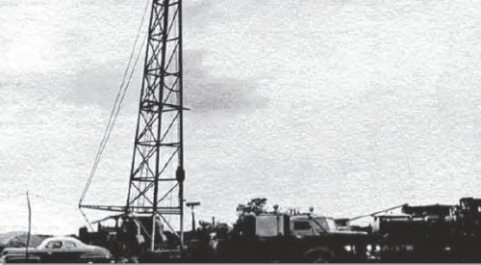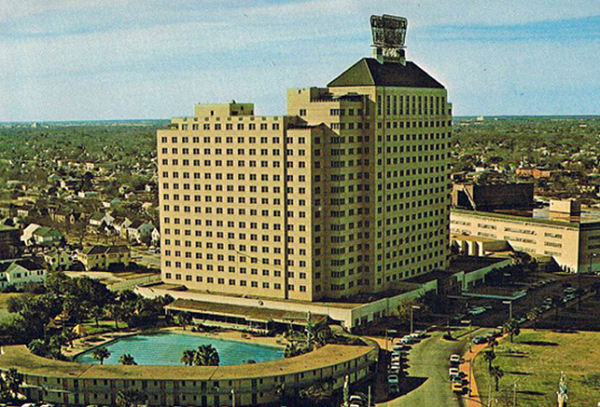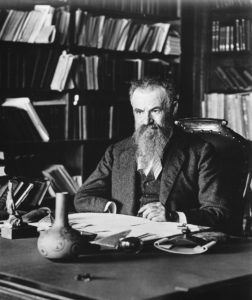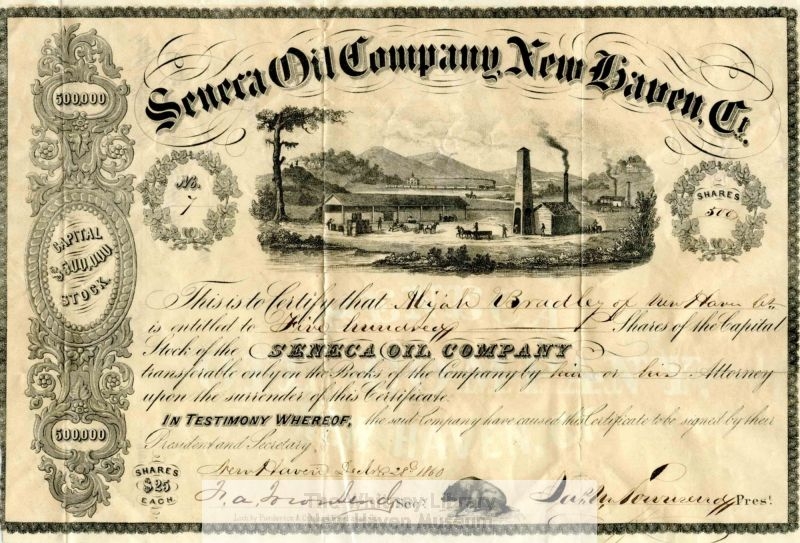by Bruce Wells | Mar 17, 2025 | This Week in Petroleum History
March 17, 1890 – Sun Oil Company founded –
Established in 1886 by Joseph Pew and Edward Emerson to provide light and heat to Pittsburgh, the Peoples Natural Gas Company expanded into production, becoming the Sun Oil Company of Ohio. The new company acquired leases near Findlay and began “producing petroleum, rock and carbon oil, transporting and storing same, refining, purifying, manufacturing such oil and its various products.”

Sun Oil Company marketed its Sun Oils brand from 1894 to 1920 and its original Sunoco brand from 1920 to 1954.
Sun Oil Company went public in 1925 with its stock appearing for the first time on the New York Stock Exchange. Four years later, a partnership with downhole gyroscope inventor Elmer Sperry created Sperry-Sun Drilling Services.
March 17, 1923 – Discovery leads to Seminole Oil Boom
The Betsy Foster No. 1 well, a 2,800-barrel-a-day oil gusher near Wewoka, county seat of Seminole County, Oklahoma, launched the Seminole area boom. The discovery south of Oklahoma City was followed by others in Cromwell and Bethel (1924), and Earlsboro and Seminole (1926). Thirty-nine separate oilfields would be found in Seminole and Pottawatomie, Okfuskee, Hughes, and Pontotoc counties. Once among the poorest regions in Oklahoma, by 1935 the greater Seminole area became the largest supplier of oil in the world.
Learn more in Seminole Oil Boom.
March 17, 1949 – First Commercial Application of Hydraulic Fracturing
A team from Halliburton and Stanolind companies converged on an oil well about 12 miles east of Duncan, Oklahoma, and performed the first commercial application of hydraulic fracturing.
A 1947 experimental well had fractured a natural gas field in Hugoton, Kansas, and proven the possibility of increased productivity. The technique was developed and patented by Stanolind (later known as Pan American Oil Company) and an exclusive license was issued to Halliburton Company to perform the process. Four years later, the license was extended to all qualified oilfield service companies.

The first commercial hydraulic fracturing job (above) took place in 1949 about 12 miles east of Duncan, Oklahoma. Photo courtesy Halliburton.
“Since that fateful day in 1949, hydraulic fracturing has done more to increase recoverable reserves than any other technique,” proclaimed a Halliburton company spokesman in 2009, adding that more than two million fracturing treatments have been pumped without polluting an aquifer.
Erle P. Halliburton patented an efficient well-cementing technology in 1921 that improved oil production while protecting the environment. The earliest attempts to increase petroleum production by fracturing geologic formations began in the 1860s.
Learn more in Shooters – A ‘Fracking’ History.

March 17, 1949 – “Diamond Glenn” opens Shamrock Hotel
Texas independent producer “Diamond Glenn” McCarthy hosted the grand opening of his $21 million, 18-story, 1,100-room Shamrock Hotel on the outskirts of Houston. McCarthy reportedly spent another $1 million for the hotel’s St. Patrick’s Day opening day gala, including arranging for a 16-car Santa Fe Super Chief train to bring friends from Hollywood.

After paying $21 million to construct the Shamrock Hotel, Glenn McCarthy spent another $1 million for its grand opening on St. Patrick’s Day 1949. The 1,100-room Houston hotel was demolished in 1987.
The Texas wildcatter, who had discovered 11 oilfields by 1945, also introduced his own label of bourbon at Shamrock, the largest hotel in the United States at the time. Dubbed Houston’s biggest party, the Shamrock’s debut “made the city of Houston a star overnight,” one newspaper reported.
Learn more in “Diamond Glenn” McCarthy.
March 18, 1937 – New London School Explosion Tragedy
With just minutes left in the school day, a natural gas explosion destroyed the New London High School in Rusk County, Texas. Odorless gas (a residual natural gas called casing-head gas) had leaked into the basement and ignited with an explosion heard four miles away. East Texas oilfield workers — many with children attending the school — rushed to the scene, as did a cub reporter from Dallas, Walter Cronkite.

Roughnecks from the East Texas oilfield rushed to the devastated school and searched for survivors throughout the night. Photo courtesy New London Museum.
Despite desperate rescue efforts, 298 people were killed that day (dozens more later died of injuries). The explosion’s source was later found to be an electric wood-shop sander that sparked odorless gas that had pooled beneath and in the walls of the school. As a result of this disaster, Texas and other states passed laws requiring that natural gas be mixed with a malodorant to give early warning of a gas leak.
Learn more about the tragedy in New London School Explosion.
March 18, 1938 — First Offshore Well drilled off Louisiana
Oil production from a well drilled by Pure Oil and Superior Oil companies helped launch the modern offshore industry. The Creole oilfield in Louisiana’s offshore Cameron Parish was the first discovered in the open waters of the Gulf of Mexico, according to the Louisiana Department of Natural Resources (DNR). “A look back at both the Creole platform and others that followed after World War II provides a glimpse of history in the making,” noted Offshore magazine in 2014.
More offshore wells followed, including the Kerr-McGee drilling platform, Kermac Rig No. 16, which in 1947 became the first offshore rig out of sight of land. By the end of 1949, offshore exploration had discovered 11 oil and natural gas fields.
Learn more in Offshore Oil History.

March 20, 1919 – American Petroleum Institute founded
Tracing its roots to World War I when the petroleum industry and Congress worked together to fuel the war effort, the American Petroleum Institute (API) was founded in New York City. Within two years, the organization had improved an 1876 French scale to measure petroleum density relative to water — a standard later adopted and called API gravity. Based in Washington, D.C. since 1969, API has lobbied on behalf of major oil and natural gas companies while maintaining standards and recommended industry practices.
March 20, 1973 – Pennsylvania Boom Town recognized as Historic
The once-famous oil boom town of Pithole, Pennsylvania, was listed in the National Register of Historic Places. An 1865 oilfield discovery at Pithole Creek launched a drilling boom for the early U.S. petroleum industry, which had begun six years earlier in nearby Titusville. The Pithole field’s production would lead to construction of the nation’s first oil pipeline, but the boom ended after about 500 days.
Learn more in Oil Boom at Pithole Creek.
March 21, 1881 – Earth Scientist becomes USGS Director
President James Garfield appointed John Wesley Powell director of the United States Geological Survey (USGS), a scientific agency established two years earlier. Powell, who led USGS for the next decade, laid the foundation for modern earth science research.

John Wesley Powell at his desk in Washington, D.C., in 1896. Photo courtesy Smithsonian Institution.
Born in 1834 at Mount Morris, New York, Powell was a Union officer during the Civil War, where he lost an arm at the Battle of Shiloh. After the war, he became a respected geologist and expedition leader, organized early surveys in the West, and helped establish USGS in 1879.
Powell advocated the national mapping standards and geodetic system still in use today. In 1884, Powell testified to Congress, “A Government cannot do any scientific work of more value to the people at large than by causing the construction of proper topographic maps of the country.”

March 23, 1858 – First U.S. Oil Exploration Company reorganizes
Investors from New Haven, Connecticut, organized the Seneca Oil Company with $300,000 in capital after purchasing the Titusville leases of the Pennsylvania Rock Oil Company, which had been founded in 1854 by George Bissell.

Seneca Oil drilled the first U.S. well. Image courtesy New Haven Museum.
Bissell, who had investigated oil seeps south of Titusville, originated the idea of producing and refining oil to make kerosene lamp fuel. The New Haven investors nevertheless excluded him from the oil exploration company.
Learn more in George Bissell’s Oil Seeps.
_______________________
Recommended Reading: Trek of the Oil Finders: A History of Exploration for Petroleum (1975); A History of the Greater Seminole Oil Field (1981); The Frackers: The Outrageous Inside Story of the New Billionaire Wildcatters
(1981); The Frackers: The Outrageous Inside Story of the New Billionaire Wildcatters  (2014).; The Green and the Black: The Complete Story of the Shale Revolution, the Fight over Fracking, and the Future of Energy
(2014).; The Green and the Black: The Complete Story of the Shale Revolution, the Fight over Fracking, and the Future of Energy (2016); Corduroy Road: The story of Glenn H. McCarthy (1951); A Texas Tragedy: The New London School Explosion
(2016); Corduroy Road: The story of Glenn H. McCarthy (1951); A Texas Tragedy: The New London School Explosion (2012); Offshore Pioneers: Brown & Root and the History of Offshore Oil and Gas
(2012); Offshore Pioneers: Brown & Root and the History of Offshore Oil and Gas (2011); Cherry Run Valley: Plumer, Pithole, and Oil City, Pennsylvania, Images of America
(2011); Cherry Run Valley: Plumer, Pithole, and Oil City, Pennsylvania, Images of America (2000); The Powell Expedition: New Discoveries about John Wesley Powell’s 1869 River Journey
(2000); The Powell Expedition: New Discoveries about John Wesley Powell’s 1869 River Journey (2017); Myth, Legend, Reality: Edwin Laurentine Drake and the Early Oil Industry
(2017); Myth, Legend, Reality: Edwin Laurentine Drake and the Early Oil Industry (2009). Your Amazon purchase benefits the American Oil & Gas Historical Society. As an Amazon Associate, AOGHS earns a commission from qualifying purchases.
(2009). Your Amazon purchase benefits the American Oil & Gas Historical Society. As an Amazon Associate, AOGHS earns a commission from qualifying purchases.
_______________________
The American Oil & Gas Historical Society (AOGHS) preserves U.S. petroleum history. Please become an AOGHS supporter and help maintain this energy education website and expand historical research. For more information, contact bawells@aoghs.org. Copyright © 2025 Bruce A. Wells. All rights reserved.









